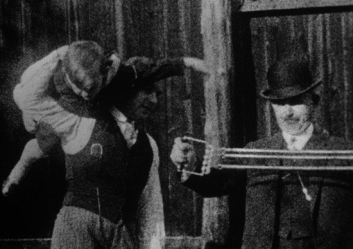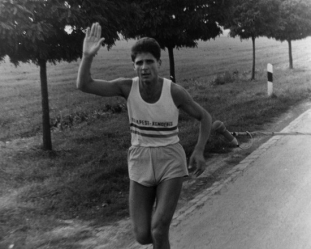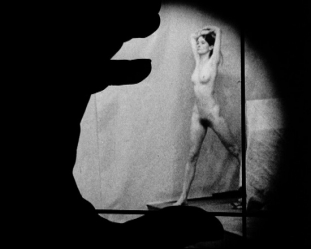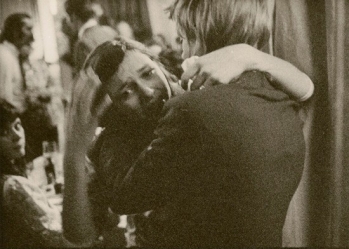Established in 1959, the Balázs Béla Studio, named after a leading film theorist and critic of the interwar period, is known for producing films by such auteurs as István Szabó and Béla Tarr. Much less known to a wide audience is the studio’s support from the early 1960s through the 1980s of experimental films by young filmmakers—not only professionals but also by artists, writers, and sociologists—whose work ranged from documentaries to structuralist and abstract works. Indeed, the “scale, scope, contents, and production situation” of experimental films that came out of BBS was remarkable and unprecedented in world cinema. As the curator and art historian László Beke commented in 1985, “Experimental filmmaking in Hungary may be surprising to Western audiences for several reasons. Most importantly, in Hungary almost all vanguard films are produced with government sponsorship at the professionally equipped Béla Balázs Studio or—less often—at other Budapest film production centers. . . . Secondly, Hungarian experimental film is characterized not only by a radical renewal of film language, but also by a rigorous unveiling of social problems [through innovative documentary films] (although these two strategies are not always equally present in every Hungarian experimental work). . . . Finally, Hungarian artists often create feature-length experimental films."[1]
Banner stills L to R: Long Distance Runner, Four Bagatelles, and New Year's Eve, all courtesy MaNDA Archive
Balázs Béla Studio (BBS)

Still from Private History, courtesy MaNDA Archive
Although the program on BBS does not include feature-length films, it does include four shorter works that, along with the films Gypsies, Self-Fashion Show, and Kalah, shown elsewhere in the series, provide an introduction to the range of filmmaking practices embraced by BBS as its members went from making unconventionally lyrical and direct, socially critical documentaries toward more experimental hybrid forms that, in Beke’s words, renewed “film language” as such.

Still from Long Distance Runner, courtesy MaNDA Archive
Together, these films tell a remarkable story, engaging with social problems under “goulash Communism” that range from the unequal treatment of ethnic minorities in Gypsies (1962) to the exploitation of average citizens’ good faith in Communism by party functionaries in Long Distance Runner (1968) and the alienation and low-brow tastes of those citizens in New Year’s Eve (1974).[2] That such films could be made at a state-run studio points to the complexity of the negotiations between the authorities and the young filmmakers at BBS. According to Beke, though the filmmakers could not control the distribution of their own films, they did receive the economic and technological resources necessary to realize ambitious experimental work for a circle of intellectuals and interested professionals, including foreign critics who in the 1960s awarded BBS films a number of prizes at the Oberhausen Short Film Festival and other competitions.[3]

Still from Four Bagatelles, courtesy MaNDA Archive
This official policy allowed several generations of young filmmakers in Hungary to transition into their profession having had the freedom and the resources to find their own voices, which led to some remarkable results. Gábor Bódy’s films, for instance, such as Four Bagatelles (1975), Private History (1978), and American Postcard (1975) (which was screened at the National Gallery in 2013), provide some of the most complex engagements with structuralism in Eastern European cinema, alongside the deep interest in the distinctive “language” of the film medium that can also be clearly seen in the work that came out of the Workshop of Film Form at the Łódź Film School in Poland and the amateur films made for the Genre Experimental Film Festival in Zagreb, Croatia, in the 1960s.

Still from New Year's Eve, courtesy MaNDA Archive
At the same time, if they crossed certain ideological lines, BBS filmmakers stood to suffer from both repression and the suppression of their work, as happened with Tamás St. Auby’s Centaur. Just as important, despite occasional screenings at festivals, BBS films by and large remained internationally undistributed and obscure. As Peter Rubin commented in 1985, “Of all the countries with major avant-garde film movements, it is Hungary which has labored the longest without getting the international recognition it richly deserves."[4] After many of the studio’s established filmmakers began to turn toward more traditionally narrative filmmaking in the 1980s, its legacy of film experimentalism faded further from the public eye, though there continued to be experimentation in the studio throughout the decade in both film and video.
When the studio lost its state funding and status as the platform for cinematic experimentation in the 1990s, it struggled to support young filmmakers, and by the early 2000s, it changed into an archive (searchable here).[5] It was thus only in the 2000s that the legacy of BBS became fully appreciated when, based on the resources of the archive, an exhibition titled Other Voices, Other Rooms—50 Years of Balázs Béla Studio at the Kunsthalle Budapest reintroduced Hungarian audiences to this important chapter in cinematic history and made available to the public thoughtfully curated DVDs of key BBS films. BBS films have been screened more in recent years outside Hungary, and our hope is that the current screenings in Washington will help bring these remarkable films to the attention of a broader audience in the United States. — Ksenya Gurshtein
1. László Beke, “Hungarian Experimental Film and the Béla Balázs Studio,” in BBS Budapest: Twenty Years of Hungarian Experimental Film (New York: American Federation of Arts, 1985), 6. (back to top)
2. In 1969, BBS announced a new policy, centering on the production of "sociological documentaries." The new program continued through 1974. László Beke, “Hungarian Experimental Film and the Béla Balázs Studio,” in BBS Budapest: Twenty Years of Hungarian Experimental Film (New York, 1985), 11. (back to top)
3. László Beke, “Hungarian Experimental Film and the Béla Balázs Studio,” in BBS Budapest: Twenty Years of Hungarian Experimental Film (New York, 1985), 7. For a list of films that received prizes at Oberhausen and elsewhere, see ibid., 10–11. (back to top)
4. László Beke, “Hungarian Experimental Film and the Béla Balázs Studio,” in BBS Budapest: Twenty Years of Hungarian Experimental Film (New York, 1985), 14. (back to top)
5. András Bálint Kovács in “A szabadság szigete” [The island of freedom], in BBS 50: A Balázs Béla Stúdio ötven éve [BBS 50: Fifty years of the Balázs Béla Studio] (Budapest, 2009), 11. I am grateful to Sonja Simonyi for drawing my attention to this fact. (back to top)
